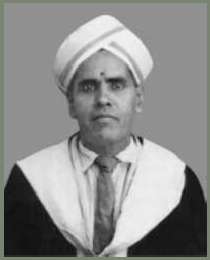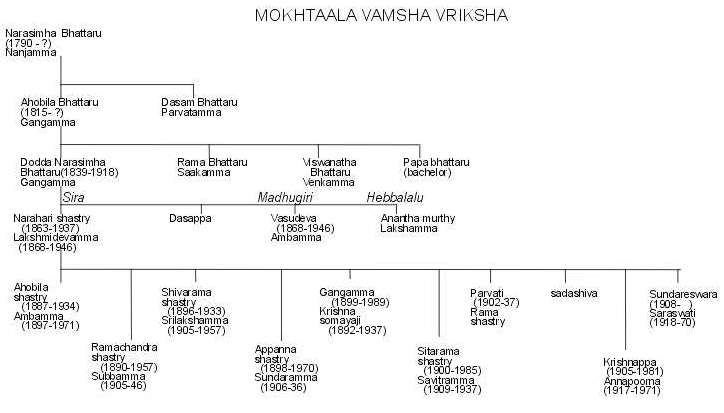
SRI NARAHARI SHASTHRI SUNDARESWARA
April 16, 1908 to Dec 16 2005
- A BIOGRAPHY
compiled and edited by Dr S. Balakrishna
| << I. Origins | >> III. My brothers |
II. Family Tree The map below shows major towns where I spent most of my life. Sira, where I was born, is at the top right hand side. The places I studied- Sira, Sringeri, Channarayapatna, Bangalore, Mysore are on this map. Sringeri is located a little south of koppa. The places I worked, Shravanabelagola, Hirisave, Mysore and Bangalore are also in the map.
|
A Family tree or genealogy commencing from the time of my father's great grandfather is appended. I very well remember my grand father Dodda Narasimha bhattaru, who died when I was 10 years old in 1918. My father Narahari shastry was his eldest son. My father was a primary school teacher drawing Rupee 15/- per month. Except for the last four years before retirement, he was moving from village to village during week-days. He was born in 1865 and died in 1937. My mother Lakshmidevamma was born in 1871 and belonged to the family of Brahmana vaidika Agnihotri's who used to worship agni thrice a day and maintained the sacred fire without being extinguished. Her native place was Kudur, a few miles from Shivaganga, 10 miles from Tumkur. Her elder brother was Bhavani Shankara Somayaji. It is learnt from my mother that her great grand mother committed sahagamana. I remember to have seen Kudur in my 8th year when my elder brother's thread ceremony was performed.
The family tree above shows the direct path from our oldest known ancestor Narasimha Bhattaru down to me and my brothers/sisters. The figure below shows the tree of Dasam Bhatta, son of the original Narasimha bhatta.
My father was eldest son of his parents, Dodda Narasimha Bhattaru and Gangamma who had four children. My father settled in Sira while his two year younger brothers Vasudeva Shastry settled in Madhugiri and Anantha murthy settled and in Hebbalalu. Vasudeva Shastry was a purohita by profession, while Anantha Murthy was a sub inspector of Excise department in our place. He maintained a horse, which he used, while on duty to ride to places of his jurisdiction. Some of the other family tree members at the top are as follows:
These persons were identified by my brother Ramachandra Shastry, and I met some of them. Our house in Sira was built in mud and roofing was also mud. This house was sold at the time of my parents death to support the aparakarma’s. My mother was not educated, but still she was an expert in preparing Ayurvedic Medicines such as Bhasma, Choorna, taila, mathre, Lehya, etc which she learnt through sanskrit sholkas in ayurveda. Moreover, she was an expert in midwifery. Ayurvedic medicines used to be given free of cost and she used to attend delivery cases amongst the Brahmin community. She was a kind hearted and generous lady. My second brother who joined taluk office as a class IV employee retired as a record keeper. Except for one year, he was throughout in Sira Taluk Office and used to assist my mother in family expenses. Those days were glorious days when people lived contented without the least worries. There were no luxuries of any kind. Bicycle was the mode of transport. My father was away in villages except on holidays and Sundays when he used to come to Sira. My mother got a good name as a host amongst the village Brahmin Shanubougas (village accountants) of Sira taluk, who used to stay as guests in our house during their stay on duty at taluk office. My mother had an interesting point to tell me that her great grand mother committed sahagamna along with her husband’s pyre some centuries ago. I am sure there was no coersion on anybody’s part since that was not normal those days and has never happened since. This took place in Kudur (probably during 1750’s), a town near Shivaganaga which a little south of Dobbspet in following map. There are no marked roads on this map leading to Shivaganga or Kudur.
This map also shows my wife’s father’s home town Motagundanahalli (also called Motaganahalli), which is a little north of first letter ‘a’ in Magadi. The road to Motaganahalli is visible and it joins the Bangalore-Magadi road to Nelamangala-Kunigal road. Map also shows the Tippagundanahalli reservoir, which is a major water source for Bangalore, to right of Magadi. My father in law Vidwaan Ramasesha Shastry went through Gurukula style of vedic education at Magadi karanikara veda paathashaala. It is here that Nrisimha Bhaarati-jagadguru of Shringeri upto 1954 was also a gurukula student. My wife talked about times when he walked to Bangalore over lands which are now submerged by Tippagundanahalli reservoir. The reservoir was built in 1920’s. Amongst my maternal uncle Bhavani Shankara Somayaji’s children, the third son Lakshminarasimha shastry had a good position. He was an Accountant General in three places in Northern India. The son of the fourth son Yagneshwara Shastry happens to be a good eye doctor (named Narasimha murthy) and is running an eye clinic in Bangalore. A rough family tree is appended.
In 1920, our olden days were golden days and everyone lived peacefully and comfortably without knowing what luxuries were. They were contented with what they earned. Their necessities in life was 'hotte-batte'- food and clothing which they had to their satisfaction. They knew not what are now called corruption, bribery, duping and other such ills. The prices of essential commodities were very cheap, rice at 5 kg per rupee even during the wartime, Ragi was sold at a rupee per bag(of 100 kg?). Thogari bele was available at kg/rupee. Gold was available at Rs 20/tola of 100 gms and silver at 50 paisa for tola. A Victoria of rupee was Rs 1 1/2 as it was being made of silver
|
Page designed by SV3Designs |





